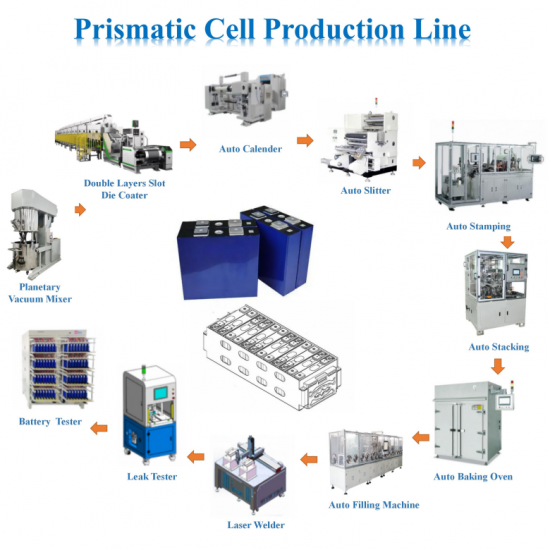Lith Corporation, founded in 1998 by a group of material science doctor from Tsinghua University, has now become the leading manufacturer of battery lab&production equipment. Lith Corporation have production factories in shenzhen and xiamen of China.This allows for the possibility of providing high quality and low-cost precision machines for lab&production equipment,including: roller press, film coater,mixer, high-temperature furnace, glove box,and complete set of equipment for research of rechargeable battery materials. Simple to operate, low cost and commitment to our customers is our priority.
What is a Car Battery Lab Line?
A Car Battery Lab Line refers to a smallscale, highly flexible, and manually operated system used for research, development, and earlystage testing of battery cells and materials. It is typically found in R&D labs, universities, innovation centers, and startup incubators, where scientists and engineers experiment with new battery chemistries, materials, designs, and performance characteristics before moving to largerscale prototype or pilot lines.
Unlike fullscale production lines or even pilot lines, a lab line focuses on exploration and experimentation rather than highvolume output. Its primary purpose is to generate data, validate hypotheses, and test the feasibility of new technologies that could eventually be scaled up into commercial products.
Key Objectives of a Car Battery Lab Line
1. Develop New Battery Chemistries
Test novel cathode/anode materials (e.g., silicon, sulfur, lithium metal)
Explore alternative electrolytes (e.g., solidstate, ionic liquids, aqueous)
Evaluate nextgeneration systems like sodiumion, zincair, or lithiumsulfur
2. Characterize Materials and Cell Performance
Measure energy density, power density, cycle life, and safety
Perform electrochemical testing under various conditions (temperature, pressure, charge rate)
3. Optimize Electrode Formulations and Manufacturing Techniques
Experiment with binder types, conductive additives, slurry viscosity
Refine coating, drying, calendaring, and stacking processes
4. Support Rapid Prototyping and Innovation
Build small batches of experimental cells for proofofconcept testing
Modify cell design, size, and structure quickly based on results
5. Generate Data for Process Scaling and Modeling
Collect process parameters and performance metrics
Feed insights into simulation tools and scaleup models
6. Train Researchers and Engineers
Provide handson experience in battery science and engineering
Build foundational knowledge for future roles in battery manufacturing
7. Comply with Safety and Regulatory Standards
Ensure safe handling of reactive chemicals and highenergy materials
Follow guidelines for flammable solvents, dust control, and waste disposal
Types of Car Battery Lab Lines
Depending on the stage of research and focus area, lab lines can be categorized as follows:
1. Material Synthesis & Characterization Lab
Focuses on developing and analyzing electrode materials, binders, and additives
Includes equipment like:
Tube furnaces for material synthesis
Xray diffraction (XRD) for crystal structure analysis
Scanning electron microscopes (SEM) for morphology study
BET surface area analyzers
2. Electrode Preparation Lab
Prepares and tests anodes and cathodes at small scale
Involves:
Slurry mixing of active materials with binders and conductive agents
Blade coating or doctorblading onto current collectors
Drying in vacuum ovens
Calendering to adjust electrode thickness and density
3. Cell Assembly Lab
Assembles and seals experimental battery cells in controlled environments
Usually includes:
Gloveboxes filled with argon or nitrogen atmosphere (<1 ppm H₂O and O₂)
Manual stacking or winding of electrodes
Spot welding of tabs and terminals
Sealing of pouch or coin cells
4. Formation & Testing Lab
Charges and discharges cells for the first time and measures performance
Uses:
Arbin, Bitrode, or Digatron battery cyclers
Thermal chambers for temperaturecontrolled testing
Impedance analyzers for internal resistance measurement
Safety cabinets for overcharge, crush, and nail penetration tests
5. Failure Analysis & Safety Testing Lab
Investigates why cells fail and how to improve durability
May include:
Postmortem analysis of failed cells
Microscopy and spectroscopy tools
Abuse testing (thermal runaway, short circuit, mechanical impact)
Typical Components and Equipment in a Car Battery Lab Line
While lab lines are not designed for mass production, they contain specialized tools for scientific investigation and earlystage development.
1. Material Preparation Tools
Planetary mixers – For preparing slurries
Ball mills – For grinding and homogenizing powders
Spray dryers – For creating spherical particles
Sintering furnaces – For calcining electrode materials
2. Electrode Fabrication Tools
Doctor blade or slotdie coaters – Apply slurry to foils
Vacuum dryers – Remove solvents under heat and low pressure
Calender machines – Press electrodes to desired thickness
Slitting machines – Cut electrodes to size
3. Cell Assembly Tools
Gloveboxes – Argon or nitrogenfilled enclosures for moisturesensitive work
Manual stackers or winders – Assemble jelly roll or stacked electrodes
Tab welders – Attach current collector tabs
Pouch sealing machines – Encapsulate components in aluminumlaminated pouches
4. Formation and Testing Equipment
Battery cyclers – Charge/discharge cycles under precise control
Environmental chambers – Simulate realworld temperatures
Data loggers – Record voltage, current, temperature during tests
Impedance analyzers – Measure internal resistance and degradation
5. Safety and Analytical Tools
Explosionproof cabinets – For testing volatile cells
Gas detection systems – Monitor hydrogen or solvent vapors
SEM/TEM microscopes – Analyze electrode surfaces and structures
Xray tomography – Nondestructive imaging of internal defects
Prismatic Cell Equipments
Supporting Infrastructure in a Car Battery Lab Line
To ensure safety, precision, and reliability, several support systems must be integrated:
1. Glovebox and Dry Room Systems
Maintain ultralow humidity (<1 ppm H₂O) for sensitive operations
Use desiccant wheels or molecular sieves for continuous air drying
Include gas purging systems (argon or nitrogen)
2. Fire Safety & Chemical Handling
Fume hoods for solvent mixing and electrode drying
Fire suppression systems using inert gases or clean agents
Spill containment and neutralization protocols
Personal protective equipment (PPE) for operators
3. Data Management & Process Logging
Laboratory Information Management System (LIMS)
Realtime monitoring of test parameters
Cloudbased storage for research reproducibility
4. Waste Management & Sustainability
Solvent recovery and recycling systems
Proper disposal of hazardous materials
Energyefficient lighting and HVAC
Applications of a Car Battery Lab Line
Lab lines are widely used across different sectors and organizations:
1. Academic Research Institutions
Universities and technical institutes conducting fundamental battery research
Training students in materials science and electrochemistry
2. National Labs and Government Agencies
Driving national battery strategies and technology roadmaps
Supporting energy independence and climate goals
3. Corporate R&D Centers
Automotive OEMs, battery suppliers, and chemical companies innovating new products
Accelerating timetomarket through rapid iteration
4. Startup Incubators and Innovation Hubs
Enabling entrepreneurs to develop breakthrough battery technologies
Providing access to shared infrastructure and expertise
5. Testing and Certification Facilities
Validating new battery materials and designs for industry adoption
Ensuring compliance with international standards (UN38.3, IEC 62660, etc.)
Benefits of a Car Battery Lab Line
Drives scientific discovery and technological breakthroughs
Enables earlystage validation of promising battery concepts
Supports rapid learning and iteration cycles
Builds deep technical knowledge and innovation capability
Provides a foundation for scaling up to pilot and production lines
Encourages collaboration between academia, industry, and government
Promotes sustainable and circular battery development
Leading Organizations Involved in Car Battery Lab Line Development
Here are some of the key players involved in designing, operating, and supporting car battery lab lines globally:
Research Institutions:
Argonne National Laboratory (USA) – Advanced battery R&D and material testing
Fraunhofer Institute (Germany) – Applied research and battery prototyping
CIC energiGUNE (Spain) – European center for advanced energy storage
KRICT (South Korea) – Battery chemistry and process development
CSIRO (Australia) – Novel materials and battery recycling research
Universities:
Stanford University (USA) – Solidstate batteries and fastcharging innovations
MIT (USA) – New chemistries and AIdriven battery discovery
University of Cambridge (UK) – Highenergydensity materials
Technical University Munich (Germany) – Industrial battery R&D partnerships
Tsinghua University (China) – Advanced battery technology and policy research
Equipment Suppliers:
MTI Corporation (USA) – Labscale battery manufacturing equipment
Neware (China) – Battery cyclers and testing systems
Hohsen (Japan) – Precision electrode coating and assembly tools
EcoChem Solutions (USA) – Solvent recovery and environmental systems
MBraun (Germany) – Gloveboxes and dry room solutions
Chemical and Material Providers:
BASF (Germany) – Cathode materials and battery chemistry
Umicore (Belgium) – NMC and LFP precursor materials
Shanshan (China) – Anode materials and battery components
3M (USA) – Advanced materials and coatings
LG Chem (South Korea) – Battery materials and R&D
Need Help Designing or Optimizing Your Car Battery Lab Line?
If you're looking to build, expand, or optimize your car battery lab line, I can help you with:
Lab layout design – Space planning, workflow, and zoning
Equipment selection – Bestinclass tools for your research goals
Dry room and glovebox integration – Humidity control and safety
Process documentation and SOPs – Standardized procedures
Training programs – For researchers and technicians
Sustainability and waste management – Ecofriendly practices
Regulatory compliance and safety protocols – Permits and risk mitigation
All you need to do is provide the following information:
Battery chemistry focus (e.g., Liion, solidstate, sodiumion)
Research objectives (e.g., material development, cell testing, failure analysis)
Available lab space and utilities
Team expertise and funding availability
Desired level of automation and digitalization



 Online service
Online service
